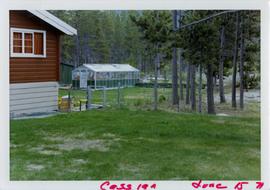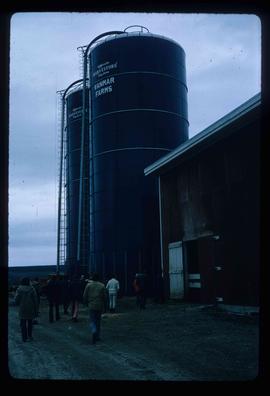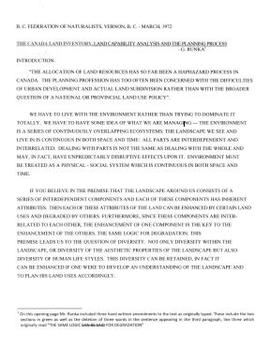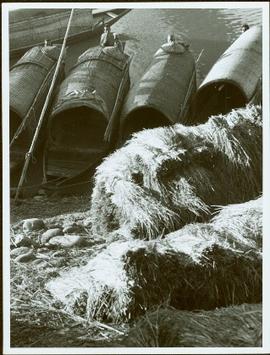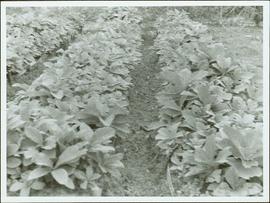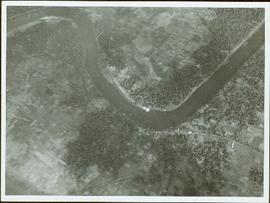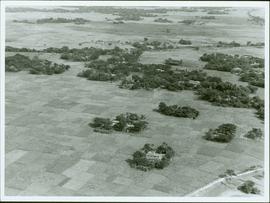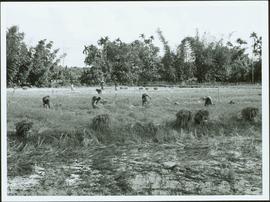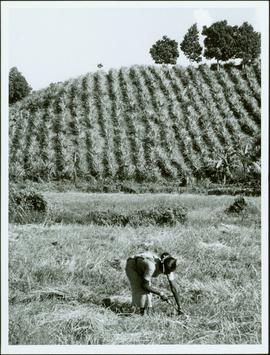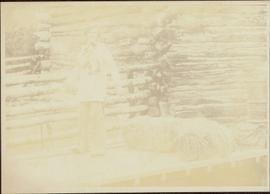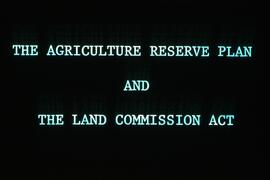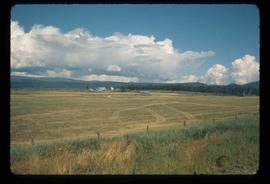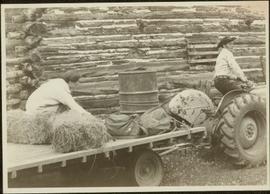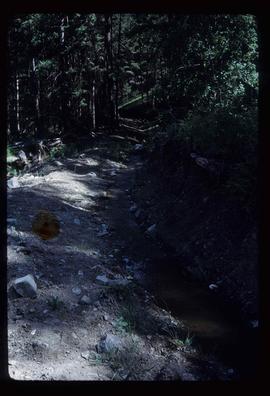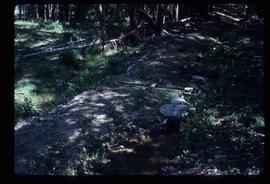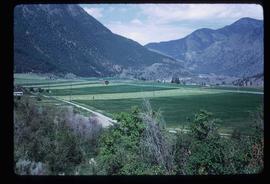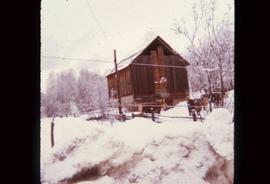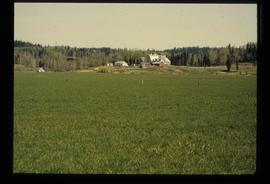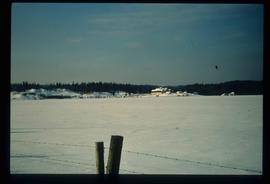Photograph depicts part of a brown and white building similar to the "Director's Lodge" at Cassiar, B.C. (see items 2000.1.1.3.19.88 and 2000.1.1.3.19.89). Unidentified individuals visible inside greenhouse in fenced back yard. Forest in background. Handwritten annotation on verso of photograph: "Cassiar June 15 71".
Item is a typescript of a paper by M. Murtha entitled "An Approach to Land-Use Planning based on the Canada Land Inventory".
Item is an original BC Department of Agriculture publication entitled "Management and Improvement of Meadows on Organic Soils of Interior British Columbia".
File consists of a speech given by Gary Runka at UBC entitled "Integrated Land Use - BC Experience".
Commentary on this speech by Barry Smith of the Ministry of Agriculture and Lands:
"The speech provides insight into GGR's concept of integrated land use as opposed to multiple land use.
Agriculture noted as often the 'primary use for land designated in the ALR'. On page 5 GGR reflects on this concept when stating that integrated land use planning is a useful first step "... to indicate the primary physical capability of each landform based on inherent soil and climatic characteristics".
The speech was accompanied by slides."
Item is an original Canada Department of Agriculture Publication 1434 entitled "Climate of the Lower Peace River Region".
Item is a copy of "Ecology and Food Production" (Vol. 4, No. 14), 1972.
Item is a copy of "The Role of Aerial Photography in the Canada Land Inventory Classification Program" prepared by Gimbarzevsky, P. for the Canadian Forestry Service Department of the Environment for Commission VII International Society for Photogrammetry.
File consists of transcripts of speeches by W. Arthur Benson entitled "Demands for and of the Land" and "Land Information and its Relevance to Planning".
File consists of a speech given by Gary Runka at UBC entitled "Land Capability Analysis".
Image depicts a barn with large, Harvestore Systems. It is possibly located on one of the many farms near Vanderhoof, B.C.
File consists of a speech given by Gary Runka to the BC Federation of Naturalists in Vernon entitled "The Canada Land Inventory, Land Capability Analysis and the Planning Process".
Commentary on this speech by Barry Smith of the Ministry of Agriculture and Lands:
"This speech largely avoids technical detail and an outlining of the mechanics of land capability analysis but does provide several practical examples that allow for a better understanding of the application of the analytical work.
The summary on page 11 is particularly important (in part):
"Planning must anticipate desirable land use patterns, not merely react to the pressure of short run expedients. Above all else let's not forget that land use planning should be people-oriented as well as resources-oriented. Hopefully, facts rather than short term
economics, politics, or emotions will play an increasing role in decision-making."
The speech was accompanied by slides.
(Note: Via a handwritten amendment the title was changed from "Land Capability Analysis and the Planning Process" to 'The Canada Land Inventory, Land Capability Analysis and the Planning Process"
Item is an original copy of "Soil Resources of the Smithers-Hazelton Area" by G.G. Runka at the Soil Survey Division, BC Department of Agriculture. Includes two accompanying maps.
File consists of a speech given by Gary Runka to the Kelowna Chamber of Commerce Environment Committee entitled "The Canada Land Inventory, Land Capability Analysis and the Chamber of Commerce".
Commentary on this speech by Barry Smith of the Ministry of Agriculture and Lands:
"GGR makes the point in opening that the Chamber of Commerce may not be a group the public normally associates with concern for the environment but he feels it is time to correct this fallacy.
This speech is of value, if for nothing else, for the outline provided of the origin of the Canada Land Inventory (page 2).
Interestingly in the light of a future Land Commission publication, GGR uses the phrase "...with proper inventory information perhaps we would have left some of our options open". The 15 page B.C. Land Commission booklet published in March 1975 [was titled 'The B.C. Land Commission: Keeping the Options Open']."
Item is a reproduced conference paper for the 4th North American Forest Soils Conference entitled "Bio-Physical Land Classification in Canada" by authors M. Jurdant (Canadian Forestry Service), D.S. Lacate (UBC), S.C. Zoltai (Northern Forest Research Center), G.G. Runka (B.C. Department of Agriculture), and R. Wells (Newfoundland Research Centre).
File consists of Gary Runka's records during his roles as general manager of the BC Land Commission (appointed 1973) and as the chairman of the Agricultural Land Commission (1975-1978) during its formative years. Includes correspondence, reports, informational material, and maps. Highlights include:
- A statement by Gordan Gram delivered 30 March 1976 entitled "Land Commission: Acquisition and Land Management"
- "Brief to the Commission of Inquiry on Property Assessment and Taxation" submitted by the B.C. Land Commission (29 April 1976)
- "Possibilities for Improved Land Management of Class 4 Lands in ALR: A Report to the British Columbia Land Commission" by Terence Lewis (12 Dec. 1975)
- Newspaper articles about the Commission's work and Runka's departure in 1978
- "Script for: Saving the Land - Bernholtz Study Project - A Slide Tape Presentation"
- "Green Paper on Planning for Agriculture: Food Land Guidelines" from the Ontario Ministry of Agriculture and Food (1977)
- "Where Have the Farm Lands Gone?" pamphlet (1979)
- "Official Regional, Settlement, Community Plan Project 1978-1979"
- "Preserving Agricultural Land: Guidelines for Action" booklet (1978)
- Gary Runka's 1978 resignation letter
Maps include:
- Photocopy of BC Provincial Land Commission, "Agricultural Land Reserve Plan, East Kootenay Regional District", map no. 82K/9, base sheet 16 of 17, last amended July 1994.
- Photocopy of BC Provincial Land Commission, "Agricultural Land Reserve Plan, East Kootenay Regional District", map no. 82G/12, base sheet 8 of 17, last amended Oct. 1995.
- Photocopy of BC Provincial Land Commission, "Agricultural Land Reserve Plan, Thompson-Nicola Regional District", map no. 92L/1, base sheet 14 of 43, original dated August 1974.
- Photocopy of BC Provincial Land Commission, "Agricultural Land Reserve Plan, Thompson-Nicola Regional District", map no. 92L/2, base sheet 15 of 43, last amended Oct. 1998.
- Reproduction of B.C. Land Inventory (C.L.I.) base map 82E/3 showing Agricultural Land Reserve Boundary in the Okanagan-Similkameen Regional District, amended to July 1996.
- Reproduction of B.C. Land Inventory (C.L.I.) base map 82E/6 showing Agricultural Land Reserve Boundary in the Okanagan-Similkameen Regional District, originally dated February 1974.
- Reproduction of B.C. Land Inventory (C.L.I.) base map 82E/12 showing Agricultural Land Reserve Boundary in the Okanagan-Similkameen Regional District, amended to Oct. 1995.
Item is a photograph of boats docked on the shore behind piles of grain or straw.
Item is a photograph of rows of plants in a garden.
Item is a photograph of a river bend and the surrounding country taken from the air.
Item is a photograph of sheaves of grain against a brick wall.
Item is a photograph of a rural area taken from the air.
File consists of a speech given by Gary Runka to the Agricultural Institute of Canada entitled "Managing Our Land Resources for Survival and Pleasure".
Commentary on this speech by Barry Smith of the Ministry of Agriculture and Lands:
"This speech is aimed at land use planning and planners, and GGR provides his definition of "ecology" which includes:
"...the basic characteristics of the land - its geology, soils, climate, vegetation, and animal life, including the devil that does the most damage, man. It also includes the interrelationships within these basic characteristics and of course this is where the word "complexities" comes in. There are no two places where these components combine in exactly the same manner and each ecological unit, if you like, is unique."
GGR mentions the importance of considering options.
This package includes a copy of the speech as well as a second, 2 page document, with the same title in which GGR is noted as 'Manager of the BC Land Commission'. This second document is largely a summary of the more formal speech."
Item is a photograph of people harvesting grain by hand.
Item is a photograph of a woman working in a field.
Item is an original copy of "Methodology - Land Capability for Agriculture - B.C. Land Inventory (CLI)" by G.G. Runka at the Soil Survey Division, BC Department of Agriculture.
File consists of a speech given by Gary Runka to the Agricultural Institute of Canada Land Use Committee entitled "Land Use Control and Jurisdictional Rights".
Commentary on this speech by Barry Smith of the Ministry of Agriculture and Lands:
"This is a first draft position paper written by GGR was developed for the Agricultural Institute of Canada, Land Use Committee.
The paper notes that attitudes are shifting from land being considered as a commodity to considering land as a natural resource. There are several references to governmental relationships, the inability to count on local governments to preserve agricultural land and the need for a federal land use policy supporting farmland preservation.
The use of a zoning tool as an effective means to preserve agricultural land is explored. The paper makes a strong case for there being no legal need for compensating land owners for regulatory land use zoning.
Included with the package are two letters written by GGR (November 7,1974) sent to Jim Lore (Alberta) and Steve Hart (Ottawa) requesting their review of the paper and input. A copy of the finalized paper, which may have been a jointly authored paper, is not included and it is not known if the paper was eventually published by the Agricultural Institute of Canada."
File consists of a 1973 BC Land Commission photographic slide and audio tape set entitled "Land Commission Act and the Agricultural Reserve Plan" that was used in original public hearings throughout the province. The 80 slides included with the presentation materials were created mostly by Gary Runka. The audio cassette is a recording of the presentation with speakers Bill Lane, BC Land Commission Chair, and Gary Runka, BC Land Commission General Manager.
Image depicts some farmland near Alexandria, B.C.
Item is an original article reprint by G.S. Swinnerton from BC Ministry of Agriculture, Fisheries and Food Technical Bulletin No. 30 on Land Capability Classification entitled "Land Classification and Environmental Planning".
Tractor pulling the trailer is being driven by the head of the family Campagnolo posed with in front of a log cabin (see item 2009.6.1.68).
Image depicts an irrigation ditch in Lillooet, B.C.
Image depicts an irrigation ditch in Lillooet, B.C.
File consists of a speech given by Gary Runka entitled "Land Use Planning as it affects the Vegetable Industry".
Commentary on this speech by Barry Smith of the Ministry of Agriculture and Lands:
"GGR gives this speech as a representative of the B.C. Land Commission and is directed at vegetable industry reps.
The ALR is mentioned a number of times and it is noted that only 1 - 2% of BC is suitable for vegetable production. Several examples (8) of pressures on agricultural land are given.
GGR draws his audience's attention to the impact of speculation when stating:
"Substantial capital gain from land development or speculation unfortunately can to some degree subvert even the best planning. .... Fortunately, this type of speculation is now on somewhat shaky ground because of the Land Commission Act in B.C."
The overall message is that vegetable producers should involve themselves in land use planning."
File consists of personal correspondence to Gary Runka during (or related to) his time at the Agricultural Land Commission. Includes letters of appreciation and correspondence with Ministers.
File consists of a speech given by Gary Runka entitled "Physical Resource Data Needs in Land Use Planning" which was given at a technical workshop to develop an integrated approach to base data inventories for Canada's Northland.
Commentary on this speech by Barry Smith of the Ministry of Agriculture and Lands:
"While the speech is not related to agriculture or farmland preservation directly, GGR emphasises the importance of data collection and mapping and its use in the planning process. The general principles he discusses were those employed in the development of the Agricultural Land Reserve.
The proceedings of the workshop were published in 1979 by Environment Canada." The proceedings are available online at: https://www.geostrategis.com/PDF/1974-04-17%20remote%20sensing%20for%20northen%20surveys%20and%20environmental%20monitoring-jean%20Thie%20CCRS%20copy.pdf
File consists of a speech given by Gary Runka to the BC Federation of Labour Environmental Conference entitled "Planned Development and Land Conservation".
Commentary on this speech by Barry Smith of the Ministry of Agriculture and Lands:
"GGR discusses the 'problem' of land being considered as either an "ecological natural resource" or "hot commodity".
He mentions that his background is in the natural sciences and land use planning and prefers to look at land as an ecological resource, not simply as a commodity.
The speech includes a quick review of the Land Commission's work and with reference to the Land Commission Act he makes the following observation (p.2):
"...the purpose is hardly necessary to relate to you - as what animal survives that destroys his food habitat next to his shelter or cover?"
The reason for BC's farmland preservation program could hardly be better stated."
Image depicts some farmland in Lillooet, B.C.
File consists of a copy of Gary Runka's resume prior to the creation of his consultancy business G. Gary Runka Land Sense Ltd.
File consists of notes written by Joan Sawicki for an untitled pending speech by Gary Runka.
Commentary on this speech by Barry Smith of the Ministry of Agriculture and Lands:
"Despite this being only 4 pages of rough notes, its focus on the initial work of the Commission and challenges of designating the ALR make it an historically important document.
For example it was initially thought the ALR would be guided by class 1 - 4 CLI ratings but this proved impractical in the north and range areas. An additional challenge was that parts of the province only had the benefit of 1:50000 mapping. This presented a very real problem for establishing the ALR.
One concern with this document is that because it is written in point form and consists of rough notes, it could be open to a degree of misinterpretation if not considered by an individual with experience in the administration of the ALR. For a much more refined statement on the B.C. Agricultural Land Preservation program and the designation of the ALR see Items [2020.4.2.1.23, 2020.4.2.1.24, and 2020.4.2.1.25]."
Image depicts a barn full of hay and several cows, possibly near Newlands, B.C.
Item is a "Report on the Victoria Symposium: The Appropriate Use of Land", held November 28-29, 1975 at the Provincial Museum in Victoria, British Columbia.
Image depicts the dairy farm in Giscome, B.C. Map coordinates 54°03'53.3"N 122°21'22.6"W
Image depicts the dairy farm in Giscome, B.C. Map coordinates 54°03'53.3"N 122°21'22.6"W
File consists of a speech given by Gary Runka to the BC Federation of Agriculture in Prince George entitled "The Land Commission and the Role of the B.C.F.A. Advisory Committee".
Commentary on this speech by Barry Smith of the Ministry of Agriculture and Lands:
"GGR uses this speech to particularly emphasize the work of the BCFA Regional Advisory Committees appointed to assist the Commission by providing advice.
Several specific examples are given of where the assistance of the Advisory Committees will be helpful.
GGR briefly outlines the work and challenges of the Commission to date. The speech ends with a list of six "general areas of concern". The list is very perceptive, revealing several of the challenges the Commission was facing at this early stage in the program including:
- Breakdown of viable production units through the sale of existing legal parcels;
- Rangeland tenure and management;
- Integrated use complications;
- Impact of major development proposals within or adjacent to the ALR;
- Small holdings owned by non-rural people in the ALR; and
- Urban re-direction away from the ALR and rural / urban interface conflicts.
The last line of p. 5 is partially hidden and reads: "...more than willing to meet with any of you individually as time permits."
Item is an original copy of an Agricultural Land Commission promotional booklet from 1975 entitled "The B.C. Land Commission - Keeping the Options Open".
File consists of a speech given by Gary Runka to the B.C.I.A. entitled "Agricultural Land Reserves and the Land Commission Act".
Commentary on this speech by Barry Smith of the Ministry of Agriculture and Lands:
"With the original package associated with this speech are 5 pages of rough notes for another speech with the same title prepared for a B.C.I.A. meeting on March 22, 1976... Given that these rough notes were held with the material associated with the April 15, 1976 meeting it is possible the B.C.I.A. meeting planned for March was shifted to the April date. Additionally there are 6 pages numbered 6-11 that are of some detail concerning the work of the Commission but appear to be part of another speech but are included with the B.C.I.A. package and have, therefore, been [included with this speech].
The title of the speech "Agricultural Land Reserves and the Land Commission Act" sums up the thrust of the speech which notes the objectives of the legislation, the Commission's program of land acquisition and Commission research and support of innovative projects to assist rural planning to create a positive environment for agriculture and give direction to urban growth away from farmland.
Additionally an overview is provided of the Commission's activities in its first two years of operation. GGR comments that establishing the ALRs "... was but a first step and we feel that it is our job to continue to protect the Reserve by whatever approaches and methods of rural planning that are available to us". This speaks to a Commission that saw its role, even at this early stage, as being much more than simply a rationing board reviewing ALR applications.
Several examples are outlined in which it is suggested that professional agrologists should be looking at carefully.
At the end of the speech (p.5) GGR includes (a note to himself) to "follow with example of an agrologist's public statement" that obviously was of concern. The actual public statement was not included with the speech given on April 15th but was included in the rough notes of the speech dated March 22 which read as follows:
"Yet a member of the B.C.I.A. - a P.Ag - is quoted in the press in response to a local politician who asked him a question something like this in regard to an ALR exclusion application:
Local politician: What about the international, national and local concerns regarding land for future food production?
BOA member P.Ag: We should firstly be concerned with places for people to live and secondly worry about land for food production.
This is our profession - the image is yours to make.
I don't mean that we should go overboard, but if we are not willing to defend preservation of agricultural land - who is?"
File consists of notes for an untitled speech about "Experiences at the B.C. Land Commission" by Gary Runka at a Habitat 1976 panel at the United Nations Conference on Human Settlements, Vancouver between May 31-June 11,1976.
Commentary on this speech by Barry Smith of the Ministry of Agriculture and Lands:
"GGR gave this speech as part of a panel at Habitat 1976.
The speech outlines the scope of the legislation, background of a provincial zoning technique (based on technical information), the establishment of the ALR plans in each of 28 regional districts and commentary on some of the projects the Commission is involved with.
Providing context to the land-use planning environment that the B.C. farmland preservation program and ALR were thrust into in the mid-1970s, GGR remarks that:
"In many cases we have local governments making their first real strong attempt at land use planning. Backed by the strength of the Land Commission Act it is seen as a real change to control urban sprawl and linear development that is detrimental from other planning points of view, as well as from the agricultural land point of view."
The fact that GGR was asked to be part of the panel at the first United Nations Conference on Human Settlements speaks to the regard given the B.C. farmland preservation program."
Item is an original work compiled by S.G. Preston for Canada Dept. of Regional Economic Expansion and BC Dept. of Agriculture ARDA III Project 89053 entitled "A Study of the Agricultural Resources & Potentials of the British Columbia Gulf Islands".
Item is a photocopied draft of a report by R.L. Davis of the Environment and Land Use Committee Secretariat entitled "A Topographic Classification to Map Spring Frost Risk for Six Deciduous Tree Fruit Varieties".
